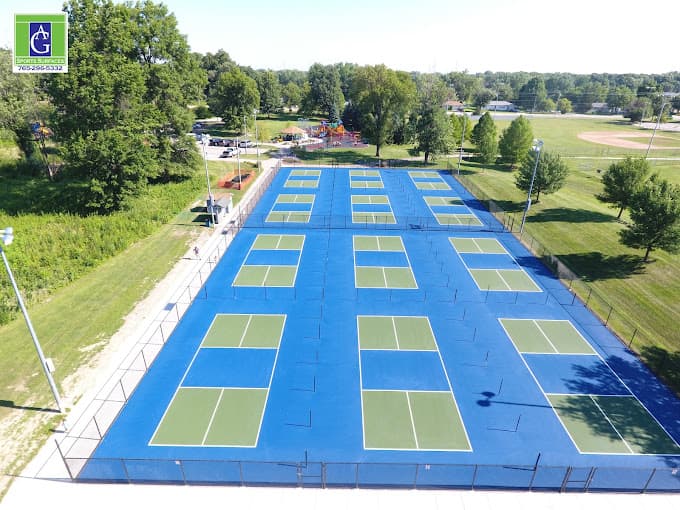Menu

Your pickleball court was the hub of activity last season—filled with rallies, tournaments, and community gatherings. But lately, you’ve noticed something troubling: fading lines, cracks spreading across the surface, and dead spots that affect play. Before you panic about a costly full rebuild, consider this: resurfacing can restore your court to like-new condition for a fraction of that price.
How much does it cost to resurface a pickleball court? In the Midwest, the average cost to resurface a pickleball court ranges from $8,500 to $12,000. Factors such as surface condition, accessibility, and whether you want to add cushioning for a softer play experience can increase the cost. At AG Sports Surfaces, we help property owners, schools, and park departments throughout Indiana, Kentucky, Ohio, and across the broader Midwest restore their courts to championship quality.
Pickleball court resurfacing involves more than just adding a new color coat. A professional resurfacing typically includes:
This comprehensive process restores both performance and appearance, ensuring consistent ball bounce, reliable traction, and a court that looks fresh for years to come.
Courts with light wear may only require minimal crack filling and patching, while older surfaces with widespread cracking may necessitate more extensive materials and labor. The extent of this repair work can shift your price closer to the top of the range.
If you want to reduce joint impact and create a softer playing surface, adding cushion layers will increase cost. Cushion systems can add $2,000–$4,000 per court, depending on the product and number of layers chosen. Many players with knee issues, aging joints, or arthritis find that cushioned courts dramatically improve comfort and reduce pain. Keep in mind that while cushioned systems may slightly affect ball speed and spin, most players find the playability and comfort benefits well worth the tradeoff.
If your court is tucked away behind a property or located far from main access roads, it can take more time to move equipment and materials, which slightly increases costs. Easy-access driveways or parking lots typically keep pricing lower.
Midwest freeze-thaw cycles and significant temperature swings can cause more cracking than in milder climates, making regular resurfacing important to protect your investment. Courts in high-traffic recreational areas may need resurfacing every 4 to 5 years, while lightly used residential courts may last 6 to 7 years between resurfacing. Harsh winters and spring thaws accelerate surface deterioration, so proactive maintenance can save thousands in structural repairs down the road.
If you’re resurfacing multiple pickleball courts simultaneously, you can expect savings of 5–15% per court, thanks to shared setup and material efficiencies. This is common for commercial facilities at parks, schools, or private communities.
Most single-court resurfacing projects in the Midwest fall between $8,500–$10,000 for standard acrylic systems, or $10,000–$12,000+ for cushioned systems or courts requiring significant crack repair. To put this in perspective, here’s how resurfacing compares to other options:
| Option | Cost | Best For |
| Targeted Repairs Only | $1,500–$3,500 | Fixes isolated cracks but doesn’t address overall wear; surface continues to deteriorate |
| Full Resurfacing | $8,500–$12,000 | Restores entire court; typically lasts 4–7 years |
| Complete Court Replacement/Reconstruction | $35,000–$80,000+ | Only necessary if structural damage extends below the surface layer |
As you can see, resurfacing offers excellent value—often restoring your court for less than half the cost of a new installation.
You’ll know it’s time for resurfacing when you see:
Resurfacing at the right time helps you avoid more costly structural repairs later. For courts that have aged past the resurfacing stage, AG Sports Surfaces also offers new court construction options.
If your pickleball court is showing signs of wear, resurfacing can restore its performance, appearance, and safety—often for less than half the cost of a new installation. AG Sports Surfaces specializes in pickleball court resurfacing across Indiana, Kentucky, Ohio, and throughout the Midwest, delivering professional results that hold up to our region’s demanding climate and heavy play.
Ready to bring your court back to life? Contact us today for a free on-site estimate and find out exactly where your court falls within the $8,500–$12,000 range.